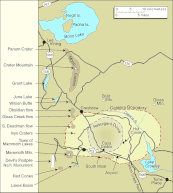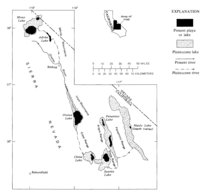Mono Lake
| Mono Lake | |
|---|---|
 Aerial view of Mono Lake from the south | |
| Location | Mono County, California |
| Coordinates | 38°01′00″N119°00′34″W/ 38.0165908°N 119.0093116°W |
| Type | Endorheic,Monomictic |
| Primary inflows | Rush Creek,Lee Vining Creek,Mill Creek |
| Primary outflows | Evaporation |
| Catchment area | 780 sq mi (2,030 km2) |
| Basincountries | United States |
| Max. length | 13 mi (21 km) |
| Max. width | 9.3 mi (15 km) |
| Surface area | 45,133 acres (18,265 ha)[1] |
| Average depth | 57 ft (17 m)[1] |
| Max. depth | 159 ft (48 m)[1] |
| Water volume | 2,970,000acre⋅ft(3.66 km3) |
| Surface elevation | 6,383 ft (1,946 m) above sea level |
| Islands | Two major:Negit IslandandPaoha Island;numerous minor outcroppings (includingtufarock formations). The lake's water level is notably variable. |
| References | U.S. Geological Survey Geographic Names Information System: Mono Lake |
Mono Lake(/ˈmoʊnoʊ/MOH-noh) is asalinesoda lakeinMono County, California,formed at least 760,000 years ago as a terminal lake in anendorheic basin.The lack of an outlet causeshigh levels of saltsto accumulate in the lake which make its wateralkaline.[2]
The desert lake has an unusually productiveecosystembased onbrine shrimp,which thrive in its waters, and provides critical habitat for two million annual migratory birds that feed on the shrimp and alkali flies (Ephydra hians).[3][4]Historically, the nativeKutzadika'apeople ate the alkali flies'pupae,which live in the shallow waters around the edge of the lake.[5]
When the city ofLos Angelesdiverted water from the freshwater streams flowing into the lake, it lowered the lake level, which imperiled themigratorybirds. TheMono Lake Committeeformed in response and won a legal battle that forced Los Angeles to partially replenish the lake level.[6]
Geology
[edit]Mono Lake occupies part of theMono Basin,anendorheic basinthat has no outlet to the ocean. Dissolved salts in the runoff thus remain in the lake and raise the water'spHlevels and salt concentration. Thetributaries of Mono LakeincludeLee Vining Creek,Rush CreekandMill Creekwhich flows through Lundy Canyon.[7]
The basin was formed by geological forces over the last five million years:basin and rangecrustal stretching and associatedvolcanismand faulting at the base of theSierra Nevada.[8]: 45

From 4.5 to 2.6 million years ago, large volumes ofbasaltwere extruded around what is now Cowtrack Mountain (east and south of Mono Basin); eventually covering 300 square miles (780 km2) and reaching a maximum thickness of 600 feet (180 m).[8]: 45 Later volcanism in the area occurred 3.8 million to 250,000 years ago.[8]: 46 This activity was northwest of Mono Basin and included the formation of Aurora Crater, Beauty Peak, Cedar Hill (later an island in the highest stands of Mono Lake), and Mount Hicks.[citation needed]
Lake Russellwas the prehistoric predecessor to Mono Lake, during thePleistocene.Its shoreline reached the modern-day elevation of 7,480 feet (2,280 m), about 1,100 feet (330 m) higher than the present-day lake. As of 1.6 million years ago, Lake Russell discharged to the northeast, into the Walker River drainage. After theLong Valley Calderaeruption 760,000 years ago, Lake Russell discharged into Adobe Lake to the southeast, then into the Owens River, and eventually intoLake ManlyinDeath Valley.[9]Prominent shore lines of Lake Russell, calledstrandlinesby geologists, can be seen west of Mono Lake.[10]
The area around Mono Lake is currently geologically active. Volcanic activity is related to theMono–Inyo Craters:the most recent eruption occurred 350 years ago, resulting in the formation ofPaoha Island.[11]Panum Crater(on the south shore of the lake) is an example of a combinedrhyolitedomeandcinder cone.[12]
Tufa towers
[edit]Many columns oflimestonerise above the surface of Mono Lake. These limestone towers consist primarily ofcalciumcarbonateminerals such ascalcite(CaCO3). This type of limestone rock is referred to astufa,which is a term used for limestone that forms in low to moderate temperatures.[13]
Tufa tower formation
[edit]Mono Lake is a highly alkaline lake, orsoda lake.Alkalinityis a measure of how manybasesare in asolution,and how well the solution can neutralizeacids.Carbonate(CO32-) andbicarbonate(HCO3−) are both bases. Hence, Mono Lake has a very high content ofdissolved inorganic carbon.Through supply ofcalciumions (Ca2+), the water will precipitatecarbonate-mineralssuch ascalcite(CaCO3). Subsurface waters enter the bottom of Mono Lake through small springs. High concentrations of dissolved calcium ions in these subsurface waters cause huge amounts of calcite to precipitate around the spring orifices.[14]
The tufa originally formed at the bottom of the lake. It took many decades or even centuries to form the well-recognized tufa towers. When lake levels fell, the tufa towers came to rise above the water surface and stand as the pillars seen today (see Lake Level History for more information).[15]
Tufa morphology
[edit]
Description of the Mono Lake tufa dates back to the 1880s, whenEdward S. DanaandIsrael C. Russellmade the first systematic descriptions of the Mono Lake tufa.[17][16]The tufa occurs as "modern" tufa towers. There are tufa sections from old shorelines, when the lake levels were higher. These pioneering works in tufa morphology are referred to by researchers and were confirmed by James R. Dunn in 1953. The tufa types can roughly be divided into three main categories based on morphology:[14][18]
- Lithoid tufa - massive and porous with a rock-like appearance
- Dendritic tufa - branching structures that look similar to small shrubs
- Thinolitic tufa - large well-formed crystals of several centimeters
Through time, many hypotheses were developed regarding the formation of the largethinolitecrystals (also referred to asglendonite) in thinolitic tufa. It was relatively clear that the thinolites represented a calcitepseudomorphafter some unknown originalcrystal.[16]The original crystal was only determined when the mineralikaitewas discovered in 1963.[19]Ikaite, or hexahydrated CaCO3,ismetastableand only crystallizes at near-freezing temperatures. It is also believed that calcite crystallization inhibitors such asphosphate,magnesium,andorganic carbonmay aid in the stabilization of ikaite.[20]When heated, ikaite breaks down and becomes replaced by smaller crystals of calcite.[21][22]In the Ikka Fjord ofGreenland,ikaite was also observed to grow in columns similar to the tufa towers of Mono Lake.[23]This has led scientists to believe that thinolitic tufa is an indicator ofpast climatesin Mono Lake because they reflect very cold temperatures.[24]
Tufa chemistry
[edit]Russell (1883) studied the chemical composition of the different tufa types inLake Lahontan,a largePleistocenesystem of multiple lakes in California, Nevada, and Oregon. Not surprisingly, it was found that the tufas consisted primarily ofCaOandCO2.However, they also contain minor constituents ofMgO(~2 wt%),Fe/Al-oxides(.25-1.29 wt%), andPO5(0.3 wt%).[citation needed]
Climate
[edit]| Climate data for Mono Lake, CA | |||||||||||||
|---|---|---|---|---|---|---|---|---|---|---|---|---|---|
| Month | Jan | Feb | Mar | Apr | May | Jun | Jul | Aug | Sep | Oct | Nov | Dec | Year |
| Record high °F (°C) | 66 (19) |
68 (20) |
72 (22) |
80 (27) |
87 (31) |
96 (36) |
97 (36) |
95 (35) |
91 (33) |
85 (29) |
74 (23) |
65 (18) |
97 (36) |
| Mean daily maximum °F (°C) | 40.4 (4.7) |
44.5 (6.9) |
50.5 (10.3) |
58.4 (14.7) |
67.6 (19.8) |
76.6 (24.8) |
83.8 (28.8) |
82.7 (28.2) |
75.9 (24.4) |
65.5 (18.6) |
51.7 (10.9) |
42.2 (5.7) |
61.7 (16.5) |
| Mean daily minimum °F (°C) | 19.7 (−6.8) |
21.5 (−5.8) |
24.8 (−4.0) |
29.5 (−1.4) |
36.4 (2.4) |
43.2 (6.2) |
49.6 (9.8) |
49.0 (9.4) |
42.8 (6.0) |
34.6 (1.4) |
27.3 (−2.6) |
21.8 (−5.7) |
33.4 (0.7) |
| Record low °F (°C) | −6 (−21) |
−4 (−20) |
1 (−17) |
12 (−11) |
16 (−9) |
25 (−4) |
35 (2) |
32 (0) |
18 (−8) |
8 (−13) |
7 (−14) |
−4 (−20) |
−6 (−21) |
| Averageprecipitationinches (mm) | 2.17 (55) |
2.21 (56) |
1.38 (35) |
0.66 (17) |
0.57 (14) |
0.36 (9.1) |
0.55 (14) |
0.45 (11) |
0.63 (16) |
0.64 (16) |
1.96 (50) |
2.32 (59) |
13.9 (352.1) |
| Average snowfall inches (cm) | 15.5 (39) |
15.3 (39) |
11.4 (29) |
3.1 (7.9) |
0.4 (1.0) |
0 (0) |
0 (0) |
0 (0) |
0 (0) |
0.7 (1.8) |
7.6 (19) |
12.0 (30) |
66 (166.7) |
| Source:http://www.wrcc.dri.edu/cgi-bin/cliMAIN.pl?ca5779 | |||||||||||||
Limnology
[edit]
Thelimnologyof the lake shows it contains approximately 280 million tons of dissolved salts, with thesalinityvarying depending upon the amount of water in the lake at any given time. Before 1941, average salinity was approximately 50 grams per liter (g/L) (compared to a value of 31.5 g/L for the world's oceans). In January 1982, when the lake reached its lowest level of 1,942 metres (6,372 ft), the salinity had nearly doubled to 99 g/L. In 2002, it was measured at 78 g/L and is expected to stabilize at an average 69 g/L as the lake replenishes over the next 20 years.[25]
An unintended consequence of ending the water diversions was the onset of a period of"meromixis"in Mono Lake.[26]In the time prior to this, Mono Lake was typically "monomictic";which means that at least once each year the deeper waters and the shallower waters of the lake mixed thoroughly, thus bringing oxygen and other nutrients to the deep waters. In meromictic lakes, the deeper waters do not undergo this mixing; the deeper layers are more saline than the water near the surface, and are typically nearly devoid of oxygen. As a result, becoming meromictic greatly changes a lake's ecology.[27]
Mono Lake has experienced meromictic periods in the past; this most recent episode of meromixis, brought on by the end of the water diversions, commenced in 1994 and had ended by 2004.[28]
Lake-level history
[edit]An important characteristic of Mono Lake is that it is aclosed lake,meaning it has no outflow. Water can only escape the lake if itevaporatesor is lost togroundwater.This may cause closed lakes to become verysaline.The reconstruction of historical Mono Lake levels throughcarbonandoxygenisotopes have also revealed a correlation with well-documentedchanges in climate.[29]
In the recent past, Earth experienced periods of increasedglaciationknown asice ages.This geological period of ice ages is known as thePleistocene,which lasted until ~11ka.Lake levels in Mono Lake can reveal how the climate fluctuated. For example, during the cold climate of the Pleistocene the lake level was higher because there was lessevaporationand moreprecipitation.Following the Pleistocene, the lake level was generally lower due to increasedevaporationand decreasedprecipitationassociated with a warmer climate.[29]
The lake level has fluctuated during theHolocene,since the end of the ice ages. The Holocene high point is at elevation 6,499 feet (1,980.8 m), reached in approximately 1820 BCE.[30]The low point before modern diversions is at elevation 6,368 feet (1,940.9 m), reached in 143 CE.[30]The lowest modern level due to diversions is at 6,372.0 feet (1,942.2 m), reached in 1980.[31]
Ecology
[edit]Aquatic life
[edit]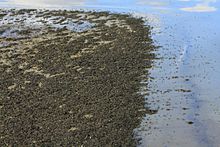
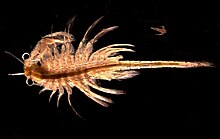
The hypersalinity and high alkalinity (pH=10 or equivalent to 4 milligrams ofNaOHper liter of water) of the lake means that no fish are native to the lake.[32]An attempt by theCalifornia Department of Fish and Gameto stock the lake failed.[33]
The whole food chain of the lake is based on the high population of single-celledplanktonicalgaepresent in thephotic zoneof the lake. These algae reproduce rapidly during winter and early spring after winter runoff brings nutrients to the surface layer of water. By March the lake is "as green as pea soup" with photosynthesizing algae.[34]
The lake is famous for the Mono Lake brine shrimp,Artemia monica,a tiny species ofbrine shrimp,no bigger than a thumbnail, that areendemicto the lake. During the warmer summer months, an estimated 4–6 trillion brine shrimp inhabit the lake. Brine shrimp have no food value for humans, but are a staple for birds of the region. The brine shrimp feed on microscopic algae.[35]
Alkali flies,Ephydra hians,live along the shores of the lake and walk underwater, encased in small air bubbles, for grazing and to lay eggs. These flies are an important source of food for migratory and nesting birds.[36]
Eightnematodespecies were found living in the littoral sediment:[37]
- Auanemaspec.,which is outstanding for its extremearsenicresistance (survives concentrations 500 times higher than humans), having 3 sexes, and beingviviparous.
- Pellioditisspec.
- Mononchoides americanus
- Diplogaster rivalis
- species of the familyMermithidae
- Prismatolaimus dolichurus
- 2 species of the orderMonhysterida
Birds
[edit]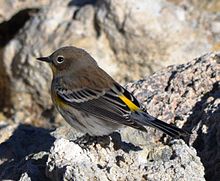
Mono Lake is a vital resting and eating stop for migratoryshorebirdsand has been recognized as a site of international importance by theWestern Hemisphere Shorebird Reserve Network.[38] Nearly 2,000,000waterbirds,including 35speciesof shorebirds, use Mono Lake to rest and eat for at least part of the year. Some shorebirds that depend on the resources of Mono Lake includeAmerican avocets,killdeer,andsandpipers.One to two millioneared grebesandphalaropesuse Mono Lake during their long migrations.[39]
Late every summer tens of thousands ofWilson's phalaropesandred-necked phalaropesarrive from their nesting grounds, and feed until they continue their migration toSouth Americaor the tropical oceans respectively.[3]
In addition to migratory birds, a few species spend several months to nest at Mono Lake. Mono Lake has the second largest nesting population ofCalifornia gulls,Larus californicus,second only to theGreat Salt Lakein Utah. Since abandoning the landbridged Negit Island in the late 1970s, California gulls have moved to some nearby islets and have established new, if less protected, nesting sites.Cornell UniversityandPoint Blue Conservation Sciencehave continued the study of nesting populations on Mono Lake that was begun 35 years ago.Snowy ploversalso arrive at Mono Lake each spring to nest along the northern and eastern shores.[40]
History
[edit]
Native Americans
[edit]Theindigenous peopleof Mono Lake are from a band of theNorthern Paiute,called theKutzadika'a.[41]They speak theNorthern Paiute language.[42]The Kutzadika'a traditionally forage alkali fly pupae, called kutsavi in their language.
The term "Mono" is derived from "Monachi", a Yokuts term for the tribes that live on both the east and west side of the Sierra Nevada.[43]
During early contact, the first known Mono Lake Paiute chief wasCaptain John.[44]
TheMono tribehas two bands: Eastern and Western. The Eastern Mono joined the Western Mono bands' villages annually atHetch Hetchy Valley,Yosemite Valley,and along theMerced Riverto gatheracorns,different plant species, and to trade. The Western Mono and Eastern mono traditionally lived in the south-central Sierra Nevada foothills, includingHistorical Yosemite Valley.[45]
Present dayMono Reservationsare currently located inBig Pine,Bishop,and several inMadera CountyandFresno County, California.[citation needed]
Conservation efforts
[edit]
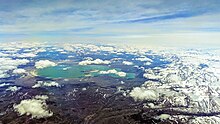
The city ofLos Angelesdiverted water from theOwens Riverinto theLos Angeles Aqueductin 1913. In 1941, theLos Angeles Department of Water and Powerextended the Los Angeles Aqueduct system farther northward into theMono Basinwith the completion of the Mono Craters Tunnel[46]between the Grant Lake Reservoir on Rush Creek and the Upper Owens River. So much water was diverted thatevaporationsoon exceeded inflow and the surface level of Mono Lake fell rapidly. By 1982 the lake was reduced to 37,688 acres (15,252 ha), 69 percent of its 1941 surface area. By 1990, the lake had dropped 45 vertical feet and had lost half its volume relative to the 1941 pre-diversion water level.[47]As a result,alkalinesands and formerly submergedtufatowers became exposed, the water salinity doubled, andNegit Islandbecame apeninsula,exposing the nests ofCalifornia gullsto predators (such ascoyotes), and forcing the gull colony to abandon this site.[48]
In 1974, ecologistDavid Gainesand his student David Winkler studied the Mono Lake ecosystem and became instrumental in alerting the public of the effects of the lower water level with Winkler's 1976 ecological inventory of the Mono Basin.[49]TheNational Science Foundationfunded the first comprehensive ecological study of Mono Lake, conducted by Gaines and undergraduate students. In June 1977, the Davis Institute of Ecology of theUniversity of Californiapublished a report, "An Ecological Study of Mono Lake, California," which alerted California to the ecological dangers posed by the redirection of water away from the lake for municipal uses.[49]
Gaines formed theMono Lake Committeein 1978. He and Sally Judy, a UC Davis student, led the committee and pursued an informational tour of California. They joined with theAudubon Societyto fight a now famous court battle, theNational Audubon Society v. Superior Court,to protect Mono Lake through state public trust laws.[49]While these efforts have resulted in positive change, the surface level is still below historical levels, and exposed shorelines are a source of significantalkalinedust during periods of high winds.[50]
Owens Lake,the once-navigable terminus of theOwens Riverwhich had sustained a healthy ecosystem, is now a dry lake bed during dry years due to water diversion beginning in the 1920s. Mono Lake was spared this fate when the California State Water Resources Control Board (after over a decade of litigation) issued an order (SWRCB Decision 1631) to protect Mono Lake and its tributary streams on September 28, 1994.[51]SWRCB Board Vice-chair Marc Del Piero was the sole Hearing Officer (see D-1631). In 1941 the surface level was at 6,417 feet (1,956 m) above sea level.[31]As of October 2022, Mono Lake was at 6,378.7 feet (1,944 m) above sea level.[31]The lake level of 6,392 feet (1,948 m) above sea level is the goal, designed to ensure that the lake would be able to reach and sustain a minimum surface level that is generally agreed to be the minimum for keeping the ecosystem healthy.[52]It has been more difficult during years of drought in the American West.[53]
In popular culture
[edit]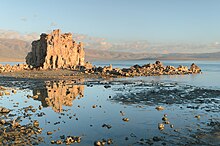
Artwork
[edit]In 1968, the artistRobert SmithsonmadeMono Lake Non-Site (Cinders near Black Point)[54]using pumice collected while visiting Mono on July 27, 1968, with his wifeNancy HoltandMichael Heizer(both prominent visual artists). In 2004, Nancy Holt made a short film entitledMono Lakeusing Super 8 footage and photographs of this trip. An audio recording by Smithson and Heizer, two songs byWaylon Jennings,andMichel Legrand'sLe Jeu,the main theme ofJacques Demy's filmBay of Angels(1963), were used for the soundtrack.[55]
The Diver,a photo taken byAubrey PowellofHipgnosisforPink Floyd's albumWish You Were Here(1975), features what appears to be a man diving into a lake, creating no ripples. The photo was taken at Mono Lake, and the tufa towers are a prominent part of the landscape. The effect was actually created when the diver performed ahandstandunderwater until the ripples dissipated.[56]
In print
[edit]Mark Twain'sRoughing It,published in 1872, provides an informative early description of Mono Lake in its natural condition in the 1860s.[57][58]Twain found the lake to be lying "in a lifeless, treeless, hideous desert... the loneliest place on earth."[59][60]
In film
[edit]A scene featuring a volcano in the filmFair Wind to Java(1953) was shot at Mono Lake.[61]
Most of the filmHigh Plains Drifter(1973) by Clint Eastwood was shot on the southern shores of Mono Lake in the 1970s. An entire town was built here for the film, and later removed when shooting was complete.[62]
In music
[edit]The music video for glam metal bandCinderella's 1988 power ballad "Don't Know What You Got ('Till It's Gone)"was filmed by the lake.[63]
See also
[edit]- Bodie,a nearbyghost town
- List of lakes in California
- Mono Lake Tufa State Reserve
- Mono Basin National Scenic Area
- GFAJ-1,an organism from Mono Lake that has been at the center of a scientific controversy over hypotheticalarsenic in DNA.
- List of drying lakes
- Whoa Nellie Deli,located inLee Vining, California,overlooking Mono Lake
- Monolake,a Berlin-based electronic music project named after the lake
References
[edit]- ^abc"Quick Facts About Mono Lake".Mono Lake Committee. Archived fromthe originalon August 20, 2019.RetrievedJanuary 27,2011.
- ^"Water Chemistry".Mono Lake Committee. January 14, 2021.Archivedfrom the original on March 28, 2024.RetrievedMay 29,2023.
- ^ab"Birds of the Basin: the Migratory Millions of Mono".Mono Lake Committee.Archivedfrom the original on August 31, 2013.RetrievedDecember 2,2010.
- ^Carle, David (2004).Introduction to Water in California.Berkeley: University of California Press.ISBN0-520-24086-3.
- ^"Mono Lake".American Museum of Natural History.Archivedfrom the original on September 22, 2023.RetrievedMay 29,2023.
- ^Hart, John (1996).Storm Over Mono: The Mono Lake Battle and the California Water Future.University of California Press.
- ^U.S. Geological Survey Geographic Names Information System: Lundy Canyon
- ^abcTierney, Timothy (2000).Geology of the Mono Basin(revised ed.). Lee Vining, California: Kutsavi Press, Mono Lake Committee. pp. 45–46.ISBN0-939716-08-9.
- ^Reheis, MC; Stine, S; Sarna-Wojcicki, AM (2002). "Drainage reversals in Mono Basin during the late Pliocene and Pleistocene".Geological Society of America Bulletin.114(8): 991.Bibcode:2002GSAB..114..991R.doi:10.1130/0016-7606(2002)114<0991:DRIMBD>2.0.CO;2.
- ^"Mono Lake".Long Valley Caldera Field Guide.USGS.Archivedfrom the original on December 29, 2014.RetrievedJanuary 13,2015.
- ^"Mono–Inyo Craters".USGS.Archivedfrom the original on January 31, 2024.RetrievedMay 31,2023.
- ^"Long Valley Caldera Field Guide - Panum Crater".USGS.Archivedfrom the original on December 11, 2023.RetrievedMay 29,2023.
- ^Ford, T.D.; Pedley, H.M. (1996). "A review of tufa and travertine deposits of the world".Earth-Science Reviews.41(3–4): 117–175.Bibcode:1996ESRv...41..117F.doi:10.1016/S0012-8252(96)00030-X.
- ^abDunn, James (1953). "The origin of the deposits of tufa in Mono Lake".Journal of Sedimentary Petrology.23:18–23.doi:10.1306/d4269530-2b26-11d7-8648000102c1865d.
- ^"Tufa".Mono Lake Committee. September 22, 2020.RetrievedMay 29,2023.
- ^abcDana, ES (1884).A crystallographic study of the thinolite of Lake Lahontan.Government Printing Office.
- ^Russell, IC (1889). "Quaternary history of Mono Valley, California".U. S. Geol. Survey 8th Ann. Rept. for 1886-1887.pp. 261–394.
- ^Russell, IC (1883). "Sketch of the geological history of Lake Lahontan".U. S. Geol. Survey 3rd Ann. Rept. for 1881-1882.pp. 189–235.
- ^Pauly, H (1963).""Ikaite", a New Mineral from Greenland ".Arctic.16(4): 263–264.doi:10.14430/arctic3545.
- ^Council, TC; Bennett, PC (1993). "Geochemistry of ikaite formation at Mono Lake, California: Implications for the origin of tufa mounds".Geology.21(11): 971–974.Bibcode:1993Geo....21..971C.doi:10.1130/0091-7613(1993)021<0971:GOIFAM>2.3.CO;2.}
- ^Shearman, DJ; McGugan, A; Stein, C; Smith, AJ (1989). "Ikaite, CaCO3̇6H2O, precursor of the thinolites in the Quaternary tufas and tufa mounds of the Lahontan and Mono Lake Basins, western United States".Geological Society of America Bulletin.101(7): 913–917.Bibcode:1989GSAB..101..913S.doi:10.1130/0016-7606(1989)101<0913:ICOPOT>2.3.CO;2.
- ^Swainson, IP; Hammond, RP (2001). "Ikaite, CaCO3· 6H2O: Cold comfort for glendonites as paleothermometers".American Mineralogist.86(11–12): 1530–1533.Bibcode:2001AmMin..86.1530S.doi:10.2138/am-2001-11-1223.S2CID101559852.
- ^Buchardt, B; Israelson, C; Seaman, P; Stockmann, G (2001). "Ikaite tufa towers in Ikka Fjord, southwest Greenland: their formation by mixing of seawater and alkaline spring water".Journal of Sedimentary Research.71(1): 176–189.Bibcode:2001JSedR..71..176B.doi:10.1306/042800710176.
- ^Whiticar, MJ; Suess, E (1998). "The Cold Carbonate Connection Between Mono Lake, California and the Bransfield Strait, Antarctica".Aquatic Geochemistry.4(3/4): 429–454.doi:10.1023/A:1009696617671.S2CID130488236.
- ^"Mono Lake FAQ".Mono Lake Committee.Archivedfrom the original on June 15, 2010.RetrievedDecember 2,2010.
- ^Jellison, R.; J. Romero; J. M. Melack (1998)."The onset of meromixis in Mono Lake: unintended consequences of reducing water diversions"(PDF).Limnology and Oceanography.3(4): 704–11. Archived fromthe original(PDF)on February 7, 2012.RetrievedNovember 13,2008.
- ^Melack, JM; Jellison, R; MacIntyre, S; Hollibaugh, JT (2017). "Mono Lake: Plankton Dynamics over Three Decades of Meromixis or Monomixis". In Gulati, R; Zadereev, E; Degermendzhi, A (eds.).Ecology of Meromictic Lakes.Ecological Studies. Vol. 228. Springer. pp. 325–351.doi:10.1007/978-3-319-49143-1_11.ISBN978-3-319-49141-7.
- ^Jellison, R.; Roll, S. (June 2003)."Weakening and near-breakdown of meromixis in Mono Lake"(PDF).Archived fromthe original(PDF)on October 30, 2008.RetrievedNovember 13,2008– via monolake.uga.edu.
- ^abBenson, LV; Currey, DR; Dorn, RI; Lajoie, KR; et al. (1990). "Chronology of expansion and contraction of four Great Basin lake systems during the past 35,000 years".Palaeogeography, Palaeoclimatology, Palaeoecology.78(3–4): 241–286.Bibcode:1990PPP....78..241B.doi:10.1016/0031-0182(90)90217-U.
- ^abStine, Scott (1990). "Late holocene fluctuations of Mono Lake, eastern California".Palaeogeography, Palaeoclimatology, Palaeoecology.78(3–4): 333–381.Bibcode:1990PPP....78..333S.doi:10.1016/0031-0182(90)90221-R.
- ^abc"Monthly Lake Levels".Mono Basin Research Clearinghouse.Archivedfrom the original on February 4, 2017.RetrievedFebruary 3,2017.
- ^"Living in an Alkaline Environment".Microbial Life Education Resources.Archivedfrom the original on November 21, 2008.RetrievedNovember 12,2008.
- ^"Frequently Asked Questions About Mono Lake".www.monolake.org.Archivedfrom the original on April 18, 2017.RetrievedJanuary 20,2017.
- ^"Mono Lake".Ecoscenario.Archived fromthe originalon September 28, 2007.RetrievedJanuary 23,2007.
- ^"Brine Shrimp".Mono Lake Committee. August 7, 2020.Archivedfrom the original on January 17, 2024.RetrievedMay 30,2023.
- ^"Alkali Files".Mono Lake Committee. August 7, 2020.Archivedfrom the original on January 17, 2024.RetrievedMay 30,2023.
- ^Shih, Pei-Yin; Lee, James Siho; Shinya, Ryoji; Kanzaki, Natsumi; Pires-daSilva, Andre; Badroos, Jean Marie; Goetz, Elizabeth; Sapir, Amir; Sternberg, Paul W. (September 26, 2019)."Newly Identified Nematodes from Mono Lake Exhibit Extreme Arsenic Resistance"(PDF).Current Biology.29(19): 3339–3344.e4.doi:10.1016/j.cub.2019.08.024.PMID31564490.S2CID202794288.Archived(PDF)from the original on March 9, 2020.
- ^"Mono Lake".Western Hemisphere Shorebird Reserve Network.Archivedfrom the original on July 27, 2011.RetrievedMay 9,2011.
- ^"Birds".Mono Lake Committee. August 7, 2020.Archivedfrom the original on April 5, 2024.RetrievedMay 30,2023.
- ^Shuford, David; Page, Gary; Heath, Sacha; Nelson, Kristie (2016). "Factors influencing the abundance and distribution of the Snowy Plover at Mono Lake, California".Western Birds.47:38–49.
- ^LAWTON, HARRY W.; WILKE, PHILIP J.; DeDECKER, MARY; MASON, WILLIAM M. (1976)."Agriculture Among the Paiute of Owens Valley".The Journal of California Anthropology.3(1): 13–50.ISSN0361-7181.JSTOR27824857.
- ^"California Indians and Their Reservations: K".SDSU Library and Information Access.Archived fromthe originalon September 26, 2010.RetrievedAugust 31,2010.
- ^Farquhar, Francis (1926).Place Names of the High Sierra.San Francisco: Sierra Club.Archivedfrom the original on June 6, 2011.RetrievedMay 28,2011.
- ^Stewart, OC."The Northern Paiute Bands"(PDF).Anthropological Records.2(3).
- ^"California Indians and Their Reservations".SDSU Library and Information Access.Archived fromthe originalon July 26, 2010.RetrievedJuly 24,2009.
- ^"Fortieth Annual Report of the Board of Water and Power Commissioners of the City of Los Angeles"(PDF).Archived(PDF)from the original on April 14, 2016.RetrievedSeptember 17,2017.
- ^"About Mono Lake".Mono Lake Committee.Archivedfrom the original on March 8, 2017.RetrievedFebruary 3,2017.
- ^"Protecting California Gulls".Mono Lake Committee. October 21, 2020.Archivedfrom the original on January 17, 2024.RetrievedMay 30,2023.
- ^abc"History of the Mono Lake Committee".Mono Lake Committee.Archivedfrom the original on February 6, 2011.RetrievedDecember 2,2010.
- ^"Dust Sources at Mono Lake".Mono Basin Research Clearinghouse.Archivedfrom the original on June 4, 2023.RetrievedMay 30,2023.
- ^Sahagún, Louis (January 2, 2023)."Conservationists fight to end Los Angeles water imports from Eastern Sierra's Mono Lake".Los Angeles Times.Archivedfrom the original on April 15, 2023.RetrievedJanuary 2,2023.
- ^Reznik, Bruce (June 27, 2023)."Opinion: A wet winter began to replenish Mono Lake. L.A. should let it be a lake again".Los Angeles Times.RetrievedJune 28,2023.
- ^"State of the Lake".Mono Lake Committee. August 7, 2020.Archivedfrom the original on April 5, 2024.RetrievedMay 30,2023.
- ^"Collection of the Museum of Contemporary Art, San Diego, 1981.10.1-2".Mono Lake Non-Site (Cinders near Black Point).1968.Archivedfrom the original on August 29, 2017.RetrievedAugust 29,2017.
- ^"Nancy Holt and Robert Smithson,Mono Lake,19:54 min, color, sound, Electronic Arts Intermix ".1968–2004.Archivedfrom the original on August 29, 2017.RetrievedAugust 29,2017.
- ^"Floyd Extra! How Wish You Were Here Went Up In Flames".MOJO magazine.September 2011. Archived fromthe originalon October 13, 2011.
- ^Twain, Mark (1996)."chapter 38".Roughing It.University of Virginia Library: Electronic Text Center.ISBN0-19-515979-9.RetrievedNovember 12,2008.
- ^Twain, Mark (1996)."chapter 39".Roughing It.University of Virginia Library: Electronic Text Center.ISBN0-19-515979-9.RetrievedNovember 12,2008.
- ^Harris, S.L. (2005).Fire Mountains of the West: The Cascade and Mono Lake Volcanoes.Mountain Press. p. 61.ISBN978-0-87842-511-2.
- ^Twain, Mark."Roughing it Chapters 38 & 39".Mono Basin Clearing House.Archivedfrom the original on September 13, 2017.RetrievedSeptember 12,2017.
- ^Harrison, Ken (March 19, 2015)."Mono in the movies: Fair Wind to java".The Sheet.
- ^Hughes, Howard (2009).Aim for the Heart.I.B. Tauris.p. 28.ISBN978-1-84511-902-7.
- ^Sweeney, Mike (July 19, 2011)."Don't Know What You Got ('Till It's Gone)".The Huffington Post.Archivedfrom the original on June 2, 2023.RetrievedJanuary 12,2014.
Bibliography
[edit]- Jayko, A.S., et al. (2013).Methods and Spatial Extent of Geophysical Investigations, Mono Lake, California, 2009 to 2011.Reston, Va.:U.S. Department of the Interior,U.S. Geological Survey.
- Miller, C.D.; et al. (1982). "Potential hazards from future volcanic eruptions in the Long Valley-Mono Lake area, east-central California and southwest Nevada: a preliminary assessment".U.S. Geological Survey Circular 877.Reston, Virginia:U.S. Geological Survey.
External links
[edit]- Mono Lake Area Visitor Information
- Mono Lake Tufa State Nature Reserve
- Mono Lake Committee website
- Mono Lake Visitor Guide
- "World Lake Database entry for Mono Lake".Archived fromthe originalon July 22, 2011.RetrievedDecember 2,2010.
- Landsat image of Mono Lake
- Roadside Geology and Mining History of the Owens Valley and Mono Basin
- Saline lakes of the United States
- Shrunken lakes
- Lakes of Mono County, California
- California placenames of Native American origin
- Inyo National Forest
- Mono people
- Native American history of California
- Lakes of the Sierra Nevada (United States)
- Lakes of the Great Basin
- Environment of California
- Tourist attractions in Mono County, California
- Endorheic lakes of California
- Environmental controversies
- Lakes of California
- Lakes of Northern California
- Geological type localities
- Eutrophication


